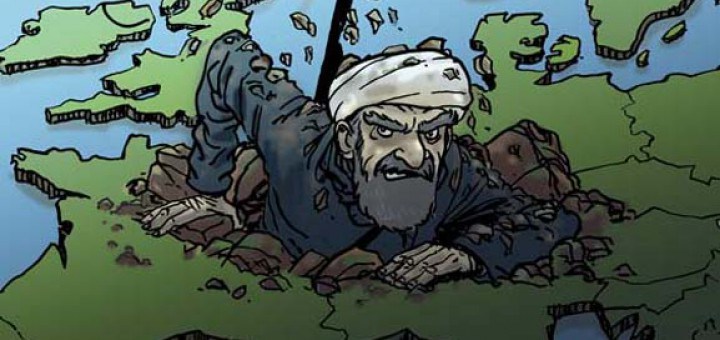The Islamic State’s battlefield defeats in Syria and Iraq will almost certainly lead to a greater focus on the group’s global operations. Europe will remain a target for both coordinated and crude attacks.
Islamic State is losing ground in the Middle East, where it is turning to more insurgency-style tactics. In parallel, it is also ramping up activities in Europe. As GRI previously forecast, 2017 has seen a rising volume of terrorist attacks perpetrated by Islamic State (ISIS) militants or Sunni extremists inspired by the group’s ideology. Despite improved threat monitoring capabilities by local intelligence services, Islamic State’s tactics in Europe are likely to continuously adapt.
Islamic State: Back to insurgency
The Islamic State is losing control over Raqqa and Dei el-Zor, the two last major cities in which it had a sizeable combat force. This comes after major defeats in the Aleppo province, Mosul, Palmyra, central and south-eastern Syria. As its territory in the Middle East shrinks, it is increasingly likely that ISIS will abandon its nation-building project to revert to armed insurgency. The legal and administrative structures that formed much of the state apparatus of ISIS in northern Syria and western Iraq have disappeared. Instead, the group will maintain a smaller and more dynamic fighting force well versed in the use of explosives and trained in surprise assaults. The volume of terrorist-style attacks on civilian soft targets will increase as ISIS operatives seek to heighten instability and insecurity in Syria and Iraq. The coordinated bombings in the Nasiriya area on 14 September were an example of this approach. This shift in tactics will enable ISIS to remain operationally active and claim periodic propaganda victories.
Focus on external operations
Meanwhile, ISIS cells will increasingly turn their attention to operations outside the Middle East. Europe will remain a key battle-ground for ISIS operatives and sympathizers. The group’s objectives will include plotting complex attacks in Western Europe as well as issuing propaganda to inspire more self-motivated lone attackers. A deteriorating Western European security environment is part of ISIS’ strategy to create divisions in European societies, maintain credibility in the eyes of its followers, and attract more acolytes. Any attack, even if unsuccessful, will be broadcast by the group’s media channels.
Since 2014, the group has explicitly sought to drive a wedge between Muslim and non-Muslim populations in Europe with the objective of destabilizing the region. The organisation will continue to use sophisticated propaganda methods in European languages, to appeal to young European Muslim populations. Also, there is a realistic possibility that radical Islamists will try to increasingly gain the support of local criminal networks, especially those linked to weapons and drugs smuggling, in order to maintain a relative freedom of action in specific European districts such as the northern suburbs of Paris or north-western neighborhoods of Brussels.
A mix of tactics
As ISIS devotes additional resources to external operations, its evolving strategy will be based on a mix of tactics. The organisation is likely to continue to attempt mass-casualty complex attacks involving small-squad assaults, coordinated bombings and maintain co-ordination between groups across borders. However, since 2015, European security services have grown increasingly capable of disrupting complex plots.
As such, it is highly probable that Islamic State militants will push their followers to plot and conduct attacks that have a comparatively higher chance of success. For this, ISIS will continue to encourage followers to carry out single-assailant attacks involving the use of vehicles, knives, firearms and homemade explosives. The Islamic State is also likely to try to carry out operations in countries that have not experienced any major terrorist incident in the last 12 months. Attacks in these locations would enable the group to avoid detection by unsuspecting local security forces, showcase its ability to hit anywhere in Europe and gain new recruitment and support areas.
Volume over quality
The Islamic State’s European strategy will almost certainly favour quantity over quality in the coming years. With its capabilities reduced by losses of territory, manpower and resources in the Middle East, ISIS will have less capacity to train commandos to hit European cities, as it did for the November 2015 attacks in Paris. The organisation will almost certainly try to capitalise on a high volume of attacks with a varying impact. As demonstrated by the Parsons Green failed bombing, the attempted stabbing of military personnel in Brussels and the failed attacks in France and Belgium, ISIS will continue to be able to cause disruption and generate a sense of insecurity regardless if the attacks it claims responsibility for are not always successful. With a high volume of operations in Europe, the Islamic State would achieve its goals of remaining at the forefront of the news cycle and instilling fear in European societies. While single-assailant and crude attacks tend to cause fewer casualties than complex operations, these will continue to negatively impact the economic, social and political environment of the affected European countries.








































admin in: How the Muslim Brotherhood betrayed Saudi Arabia?
Great article with insight ...
https://www.viagrapascherfr.com/achat-sildenafil-pfizer-tarif/ in: Cross-region cooperation between anti-terrorism agencies needed
Hello there, just became aware of your blog through Google, and found ...